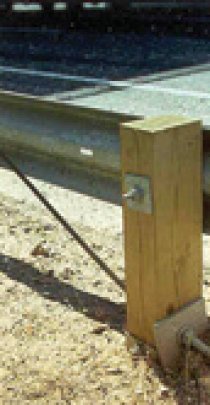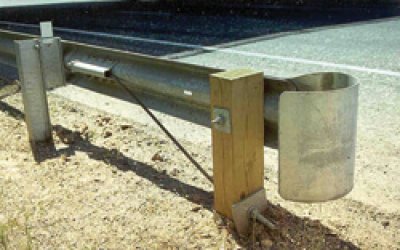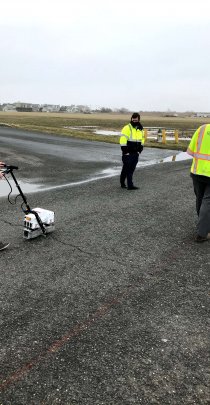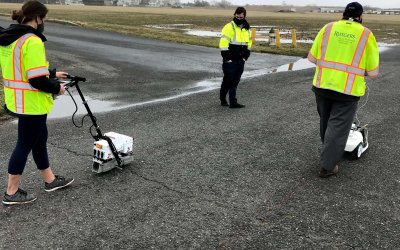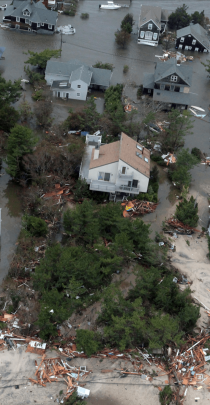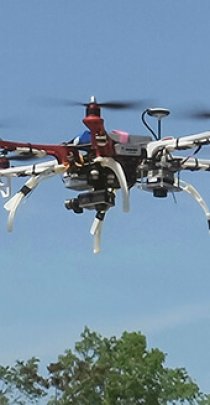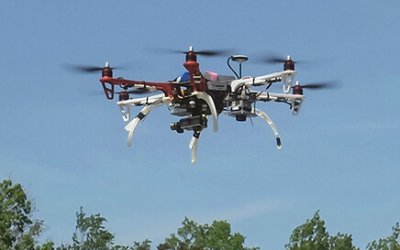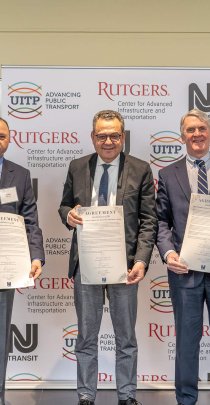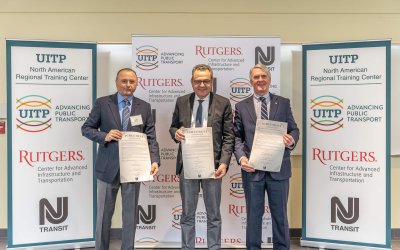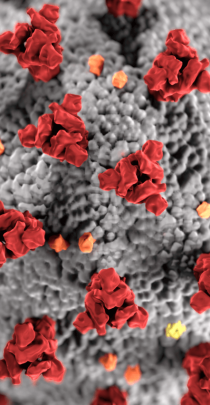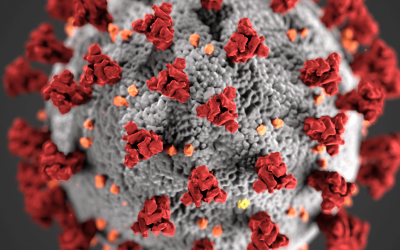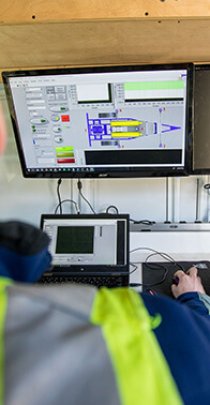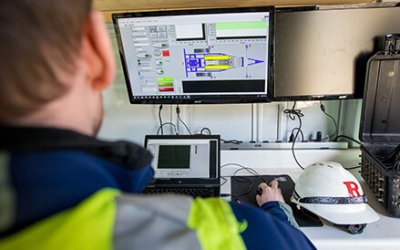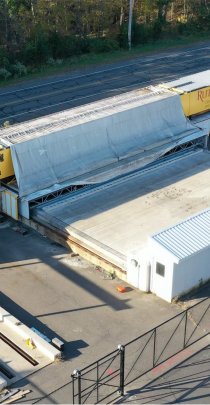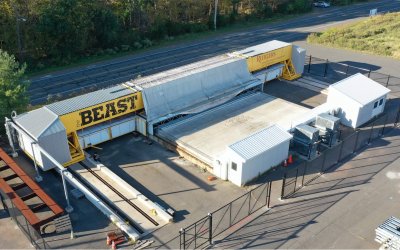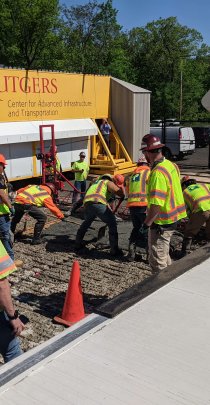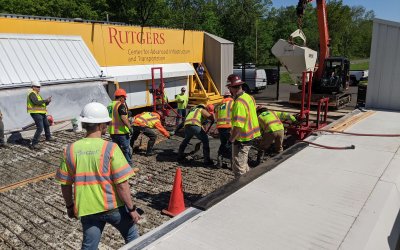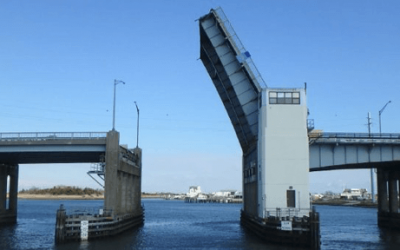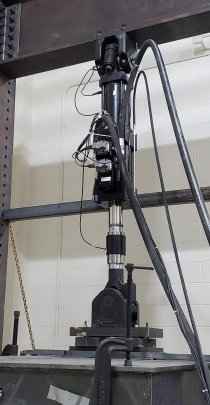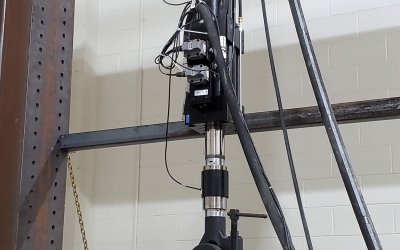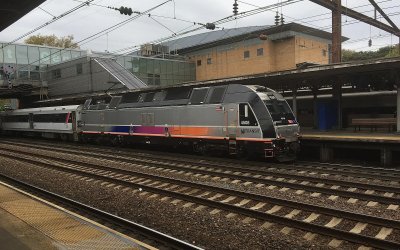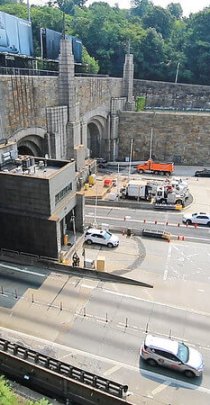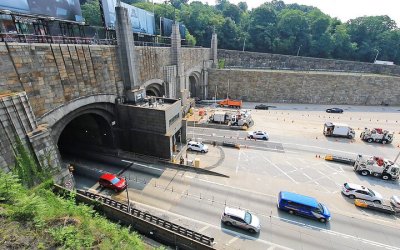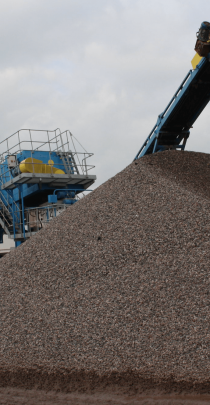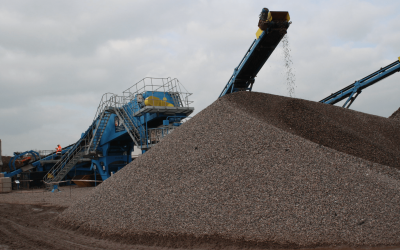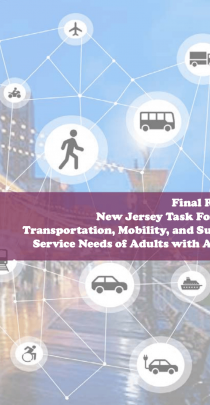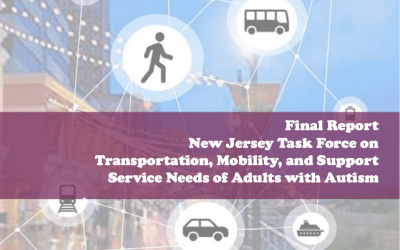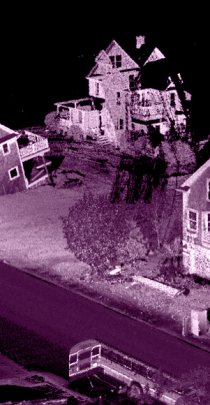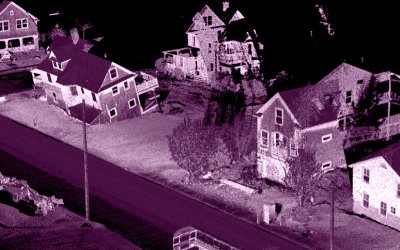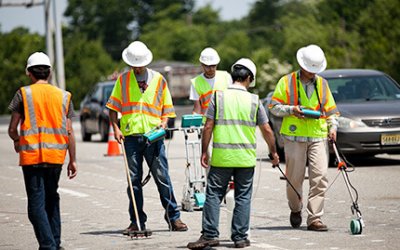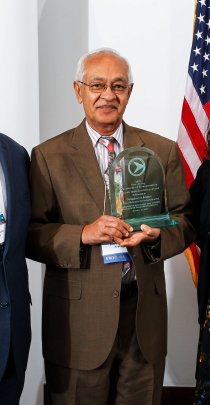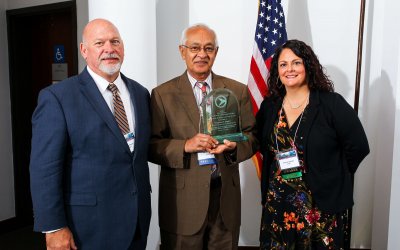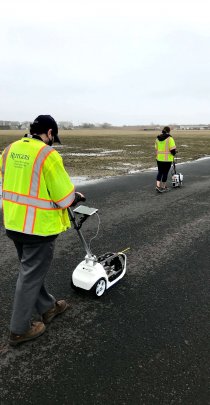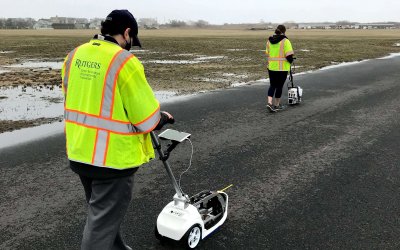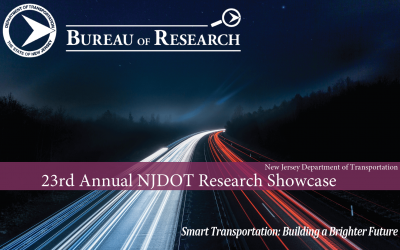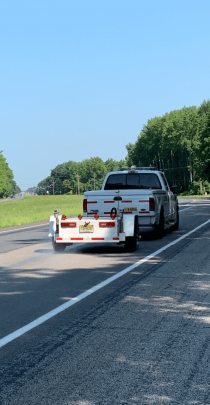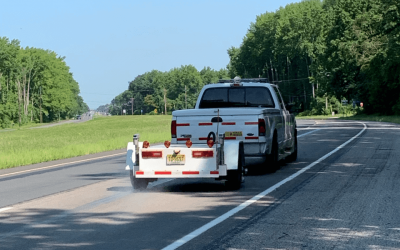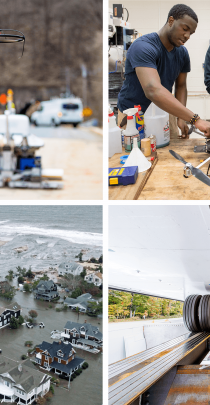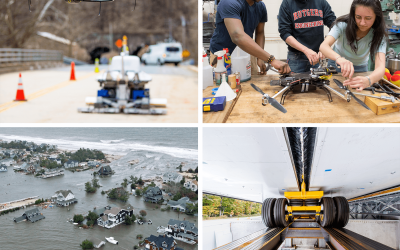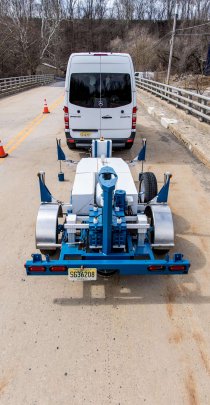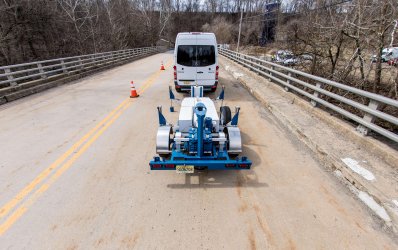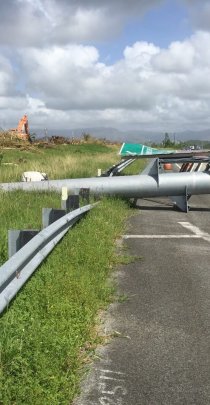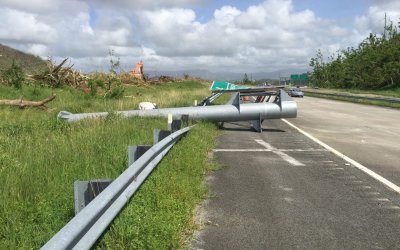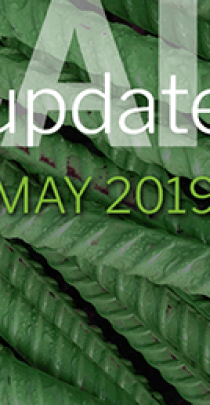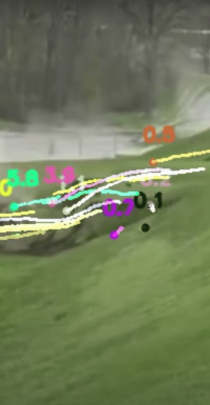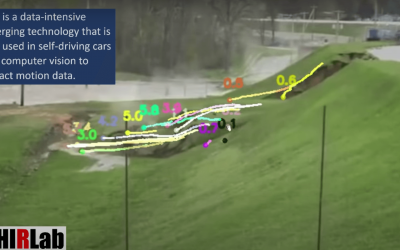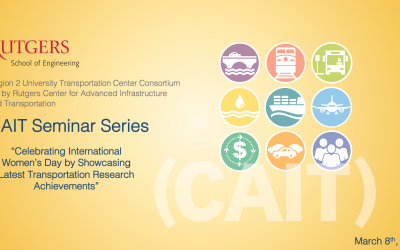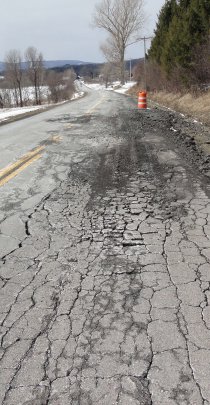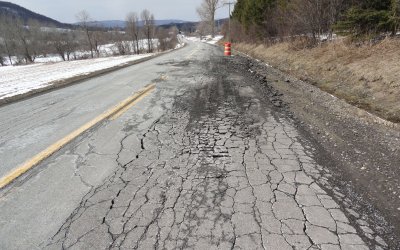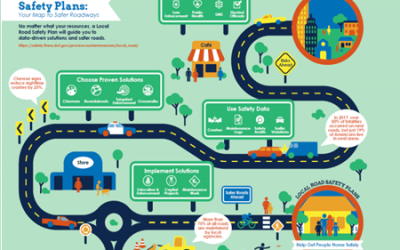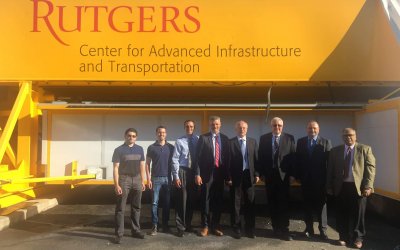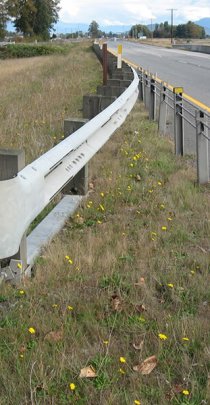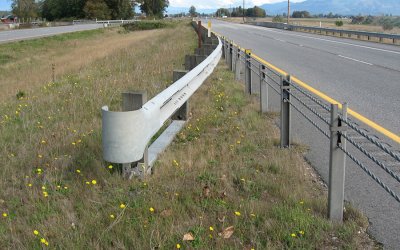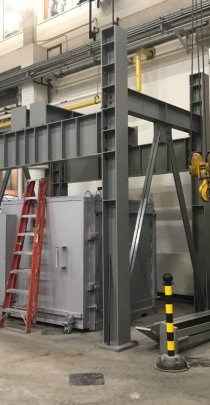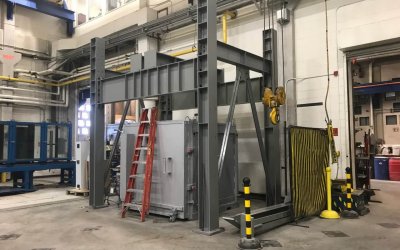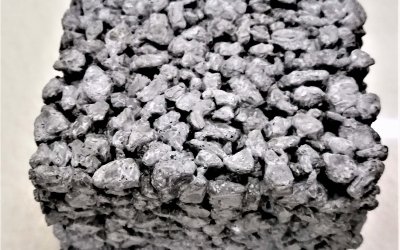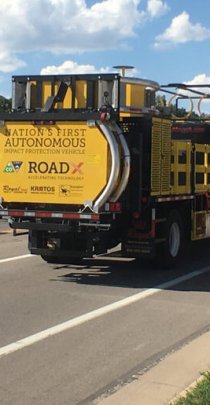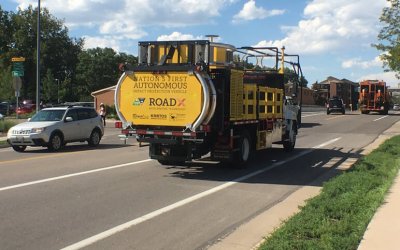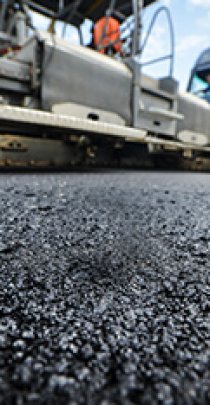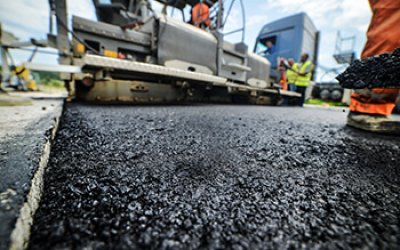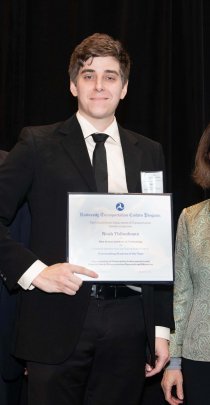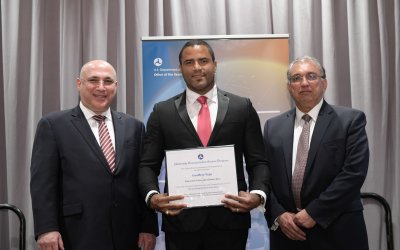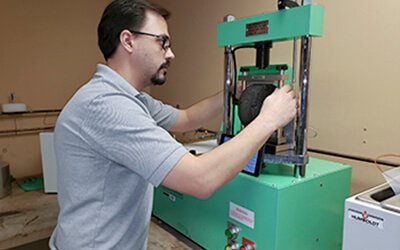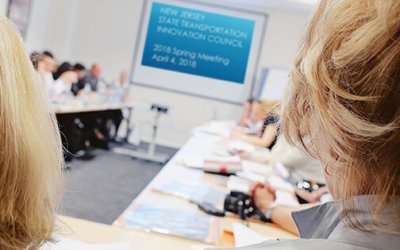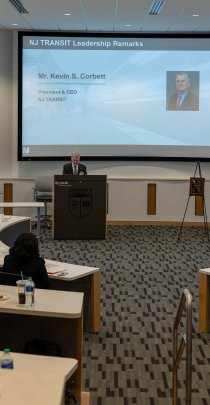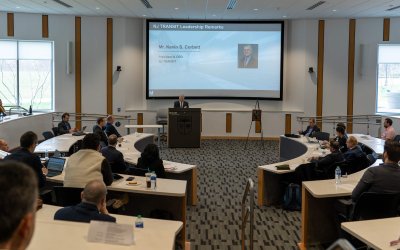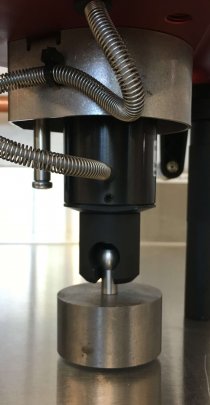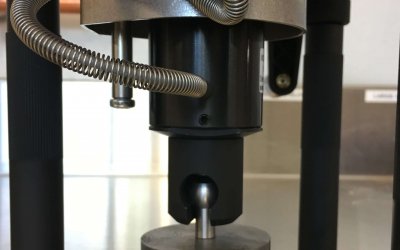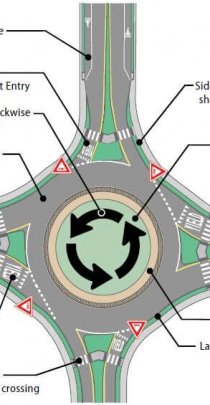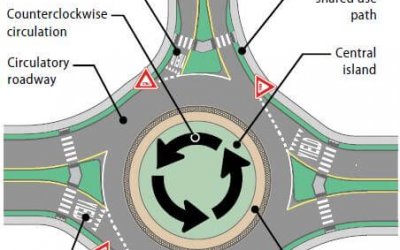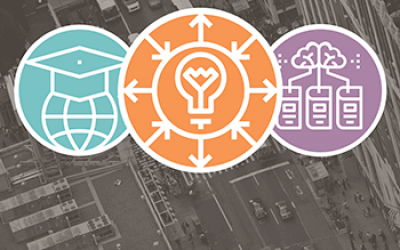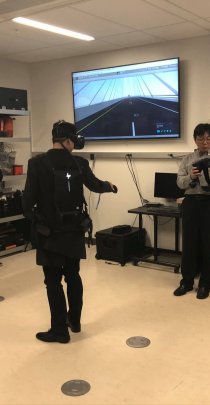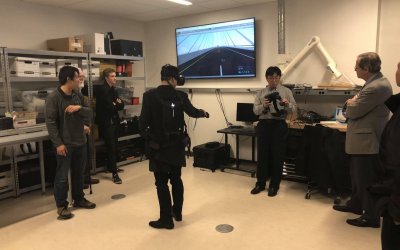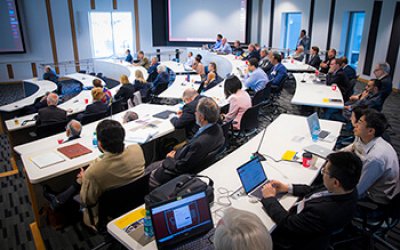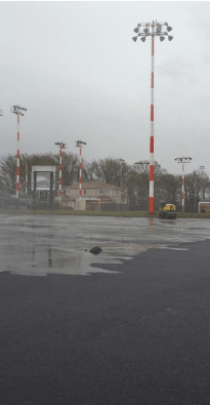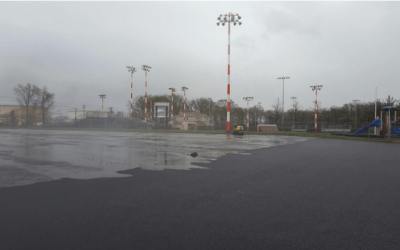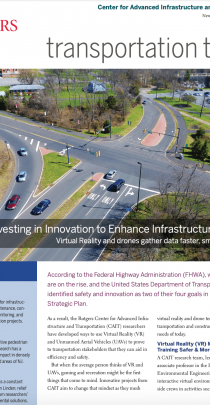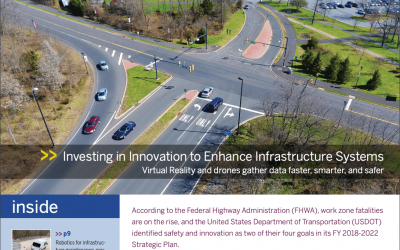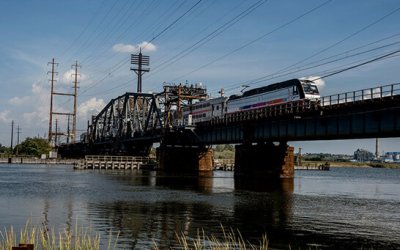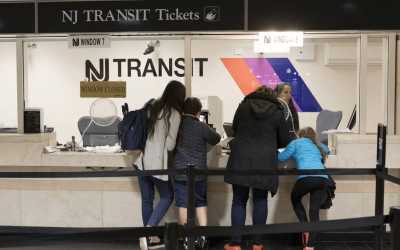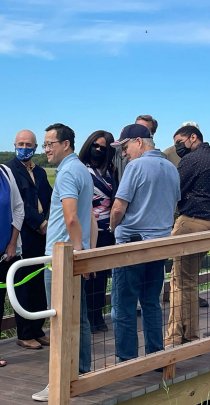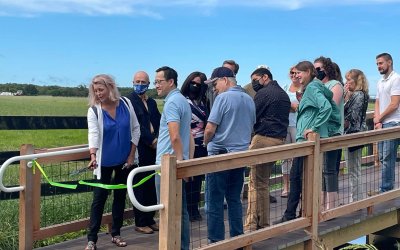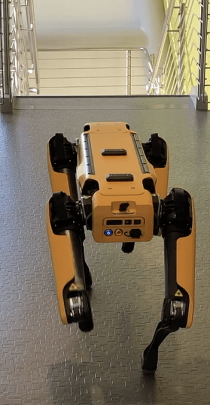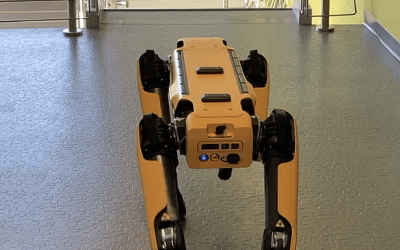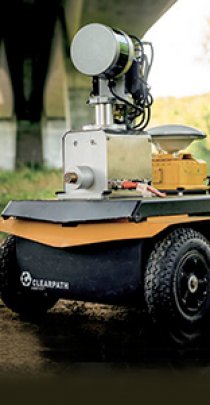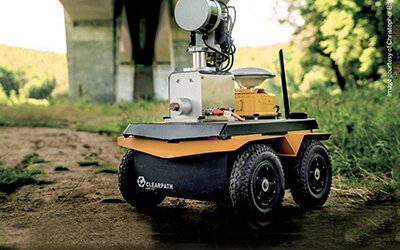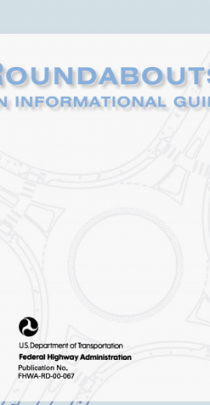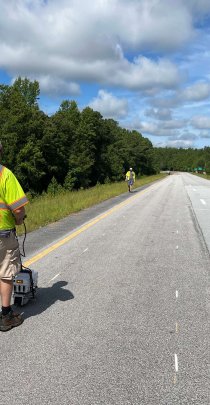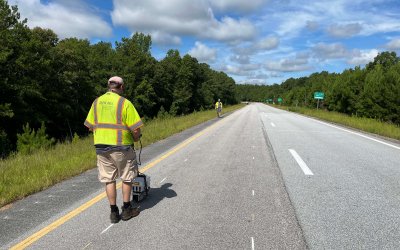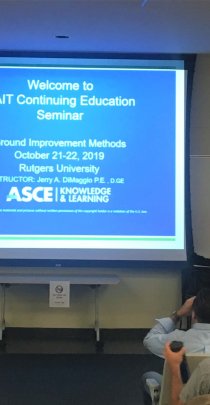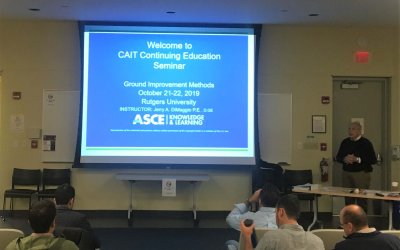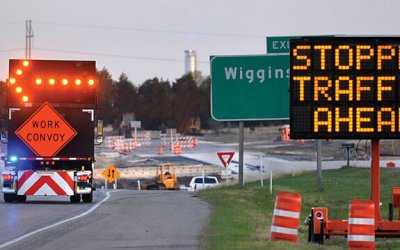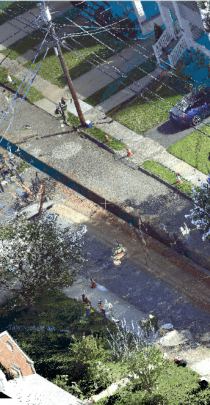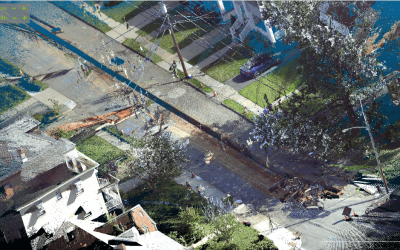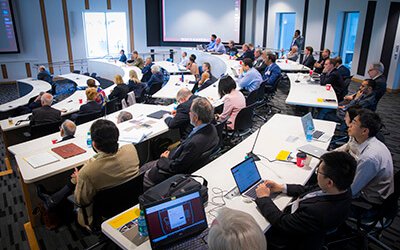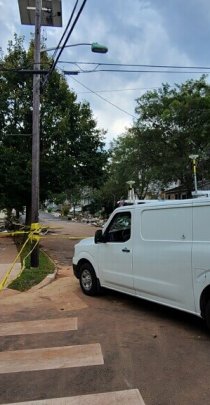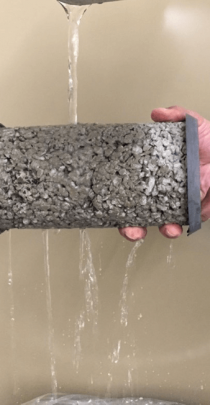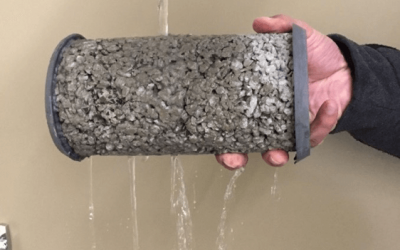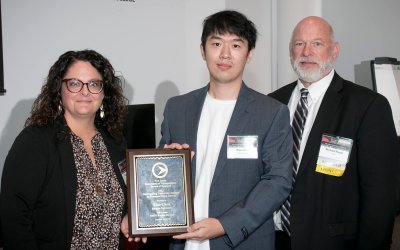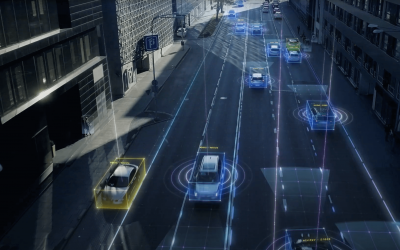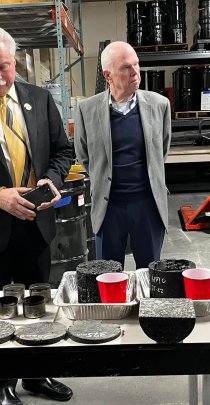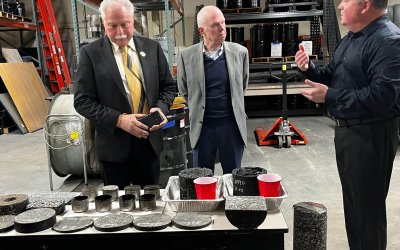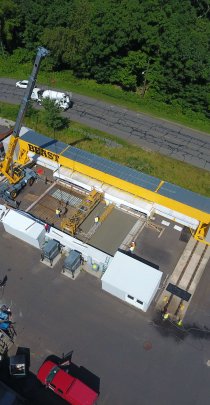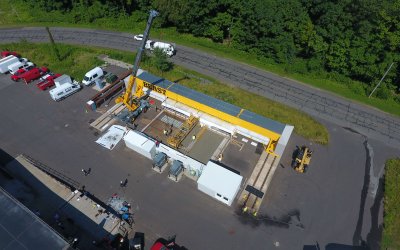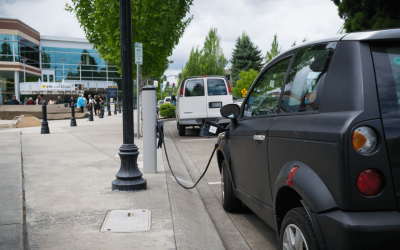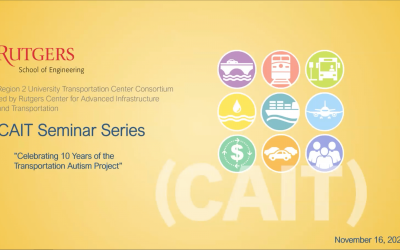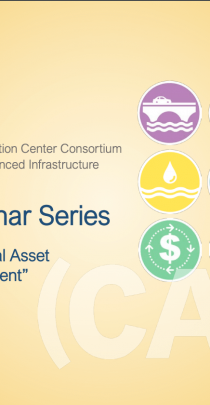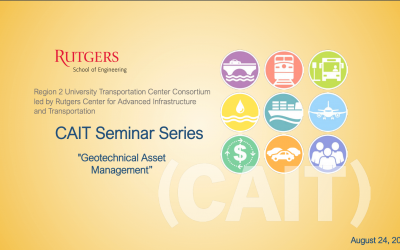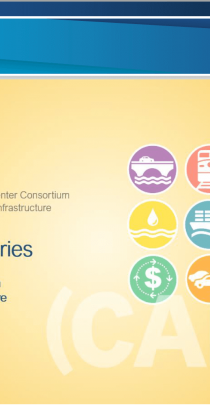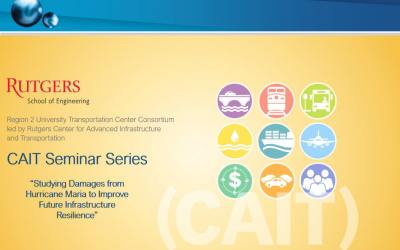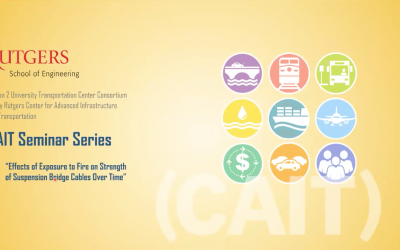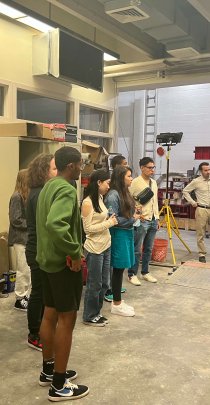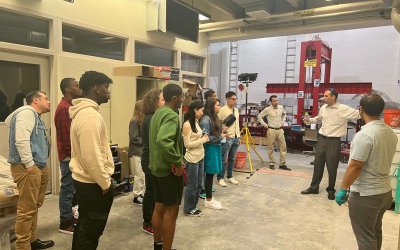Building better and smarter. Research gives birth to tools, methods, and materials that improve construction quality and efficiency, and make what we build stronger, safer, and more durable.
Training & Events
NJLTAP - Highway Inspection Procedures for Federal-aid Projects (In-Person)
This course is designed specifically for project engineers, project inspectors, supervisors and those in responsible charge of federal aid construction projects. It presents essential requirements and procedures for insuring conformance with contract plans and specifications including records and documentation necessary to
**CLASS FULL** NJLTAP - Guidelines for Guide Rail and Median Barrier Design (In-Perso
This 2-day workshop will cover the current design guidelines in Section 8 of the NJDOT Roadway Design Manual, covering clear zone, warranting obstructions, guide rail height, clearance from traveled way, rubrail, reduced post spacing at obstructions, guide rail at structures, and more.
NJLTAP - Pavement Management Systems (In-Person)
Pavement Management Systems provides the basics for developing a pavement management system to help local governments manage their pavement network by providing an understanding of the concept and importance of road surface inventories and condition surveys.
NJLTAP - Commonsense Solutions for Intersection Problems (In-Person)
This course provides participants with (1) a basic understanding of intersection safety issues, (2) “how to” information for common safety tasks and low cost safety improvements that do not require an engineered design, and (3) background information on safety tasks that do not require an engineer.
NJLTAP - Guide Rail and Median Barrier Inspection (In-Person)
This 1-day workshop will cover the current guide rail and barrier curb construction details in the NJDOT Standard Roadway Construction Details regarding their proper inspection.
NJLTAP - Principles of Paving (In-Person)
This course is for municipal or county employees and those that work with them who are involved in the planning, inspecting and placing of asphalt pavements. The course will provide the information needed to properly plan and monitor a hot mix asphalt paving project.
News
2022 Northeast Coastal Conference Highlights Resilience Work Since Superstorm Sandy
On the 10th Anniversary of Superstorm Sandy, the 2022 Northeast Coastal Conference brought together experts and industry leaders to discuss what we have learned, ongoing research and projects that are making our shores and coastal communities safer, and new ways we can continue to build a more resilient future.
For students who dream of flying
A grant from the NSF helped launch Atlantic Cape Community College’s new associate’s degree program in applied science with a concentration on small commercial drone field technicians.
CAIT Partners with NJ TRANSIT and International Association on Rail Training Center
A new center designed to educate the current and next generation of transportation leaders to be resilient to challenges of the 21st century has been established at Rutgers through a partnership with two industry leaders.
An Updated Look at The Effects of COVID-19 on Transportation and Infrastructure
Last month we spoke to CAIT-affiliated researcher Dr. James Hughes to discuss COVID-19 and its potential impacts on the economy and regional transportation. Now we check back with him again for new insights as the situation progresses.
THMPER featured in Civil Engineering magazine
The February 2018 issue of CE magazine featured THMPER—a portable, rapid testing device for bridge load-bearing capacity. THMPER is a breakthrough because it does this critical task faster, cheaper, and with less traffic disruption than other current methods.
UHPC Bridge Preservation & Repair Research at The BEAST
CAIT's BEAST Lab has been testing a full-scale, 50-ft. bridge deck for a project sponsored by the FHWA to learn about how the bridge deteriorates under exposure to extreme environmental conditions and traffic loading — and to evaluate emerging bridge preservation technologies such as UHPC.
BEAST Lab Studies Innovative UHPC Material for Bridge Preservation & Repair
This summer, the BEAST Lab at Rutgers CAIT began to evaluate emerging bridge preservation technologies in addition to ongoing testing of a full-scale, 50-ft. bridge deck. Specifically, researchers started investigating UHPC to establish measurements of the material’s long-term performance under real-world conditions.
Building the right roads for the right loads
David Orr from the Cornell University Local Roads Program is working on a tool to help towns with low-volume rural/local roads plan and build them in keeping with the traffic loads they carry.
CAIT Associate Director Elected CUTC VP for 2021-2022
Dr. Szary leads CAIT’s research efforts helping to align them with USDOT’s national vision and the needs of stakeholders in the Northeast region. He has been a member of CUTC’s executive board previously, most recently serving as Secretary last year.
CAIT Awarded Bridge Resource Program to Support NJDOT Research
The BRP is aimed at preserving bridges in the state, enhancing the condition of key transportation infrastructure, and developing new technologies to help engineers build with resilience in mind.
CAIT Director Discusses Infrastructure Resilience and Climate During ITRC Seminar
As the economic impact of climate change on infrastructure continues to grow, it is important to consider these impacts in future resilience planning. CAIT Director Dr. Ali Maher discussed this and more in a recent presentation during the ITRC Seminar Series.
CAIT Director Named to NJ’s Restart and Recovery Advisory Council
New Jersey Governor Phil Murphy recently announced the formation of a statewide council of leaders from various industry, community, and faith-based groups and institutions across New Jersey to work together and advise on the state’s restart and recovery from the COVID-19 pandemic.
CAIT Expands Large-Scale Testing Equipment for Bridge-Deck Development Research
Rutgers CAIT recently enhanced capability in large-scale structural-testing equipment that will enable full utilization of its existing laboratory infrastructure and expand its portfolio in transportation research by providing access to a capability that currently does not exist in any other university in NJ and the region.
CAIT Helps Secure Funding for Advancement of Portal North Bridge Replacement Project
The 110-year-old Portal North Bridge carries approximately 450 trains and 200,000 passengers on an average day, and is in need of repair. CAIT helped to secure new funding from FRA that will allow NJ Transit and other stakeholders to advance these vital infrastructure projects.
CAIT Launches Infrastructure Asset Management Academy
The Infrastructure Asset Management Academy for Engineers and Planners is a 6-course program taught by experts at CAIT and industry partners designed to provide students with the knowledge, tools, and experience needed to make more informed asset management decisions.
CAIT Partners with ARA on Geotechnical Research Contract
ARA was selected as a contractor to provide program support and engineering services to the FHWA’s Office of Bridges and Structures and National Geotechnical Team. CAIT has teamed up with them as a subcontractor to provide research support and expertise.
CAIT pavement crew wants agencies to join the RAAT-Pack
Modern asphalt pavement performance testing has evolved quickly. The physical testing procedures are relatively simple, but analyzing the collected data is complex and intensive. If you’re an asphalt technician or engineer, that’s where RAAT-Pack has your back.
CAIT Research Helps NJ Transit Secure Funding for State of Good Repair Projects
The FRA issued a notice of funding opportunity for state of good repair projects including a total of $291.4 million in grant funding to help repair vital intercity passenger rail assets. Of that funding, NJ Transit was later awarded $18.3 million to upgrade the Trenton Transit Center, and CAIT helped to secure it.
CAIT Research Helps NYC Engineers Monitor Structural Health of Manhattan Bridge
Researchers are developing a new tool to monitor track misalignment on the Manhattan Bridge that will help NYC engineers make informed repair and rehabilitation decisions in the future. They are also investigating the impact of dynamic amplification on bridge-fatigue life and possible mitigation options.
CAIT Research Helps Port Authority Adopt Leading Sustainable Concrete Standards
New Low-Carbon Concrete Requirements Mark Significant Milestone in Agency’s Clean Construction Program; Advance Agency’s Commitment to Reducing Direct Emissions.
CAIT Research Provides Guidelines on Recycled Concrete Aggregate Implementation
Due to how it is sourced and produced, the mechanical properties and characteristics of Recycled Concrete Aggregate can vary greatly. As demand for this material grows, it is important for the construction industry to understand the nature of RCA and how it can be applied to different projects.
CAIT Researcher Awarded 2-Year FEMA Hazard Mitigation Grant to Continue Infrastructur
Dr. Jie Gong’s recent work has focused on promoting coastal urban community resilience, including leading remote sensing-based post-disaster reconnaissance missions during Hurricane Sandy and other storms with the goal of advancing damage assessment methods and turning data into actionable resilience knowledge.
CAIT Researcher Co-Edited New Book on Eco-efficient Pavement Construction Materials
"Eco-efficient Pavement Construction Materials" provides engineers with the latest information and research on eco-efficient pavement materials and green infrastructure.
UTC Research Compares Pavement Condition Indexes To Help Estimate Service Life
New research from Rutgers CAIT is examining the consistency and relationship of three Pavement Condition Indexes. Analyzing them can result in more durable and sustainable airfield pavement in the long-term, and has the potential to help find improvements to the current practices in airfield-pavement management systems.
CAIT Researcher Helps NJ Lessen Barriers to Transportation Support Services
A new report from the New Jersey Task Force on Transportation, Mobility, and Support Service Needs of Adults with Autism highlights and identifies State policies and programs that can be improved to help remove or lessen barriers and enhance access to transportation for those with disabilities.
Dr. Husam Najm Named Educator of the Year by ASCE Central Jersey Branch
ASCE Central Jersey honors members dedicated to the advancement of engineering every year at its annual awards ceremony. This year, they selected CAIT-affiliated researcher Dr. Husam Najm for the Educator of the Year Award due to his dedication in helping educate the next generation of civil engineers at Rutgers.
CAIT Researcher Speaks at Capitol Hill on Gaps in Infrastructure Resilience
The Coastal Universities Coalition is a consortium of the nation’s leading academic institutions convened to develop science-based solutions to the most pressing issues facing populated coastal regions. This month, a CAIT researcher was invited by the organization to speak on infrastructure resilience.
CAIT Researcher Speaks on the State-of-the-Art in NDE and Bridge Assessment Tech
On September 16th from 2-3 pm, Rutgers Center for Advanced Infrastructure and Transportation (CAIT) hosted affiliated researcher Dr. Nenad Gucunski for a presentation on the state-of-the-art in the use of Nondestructive Evaluation and other technologies for the comprehensive assessment of concrete bridges.
How Climate Change May Impact the Life-Cycle of Asphalt Pavement
Changing global climate patterns and warming temperatures are increasing the risk and vulnerability of numerous key transportation infrastructure assets, and new research from a CAIT-affiliated researcher suggests that this may include asphalt pavements as well.
CAIT Researcher Validates Paratransit Skills Assessment and Wins TRB Best Paper Award
A recent paper from Rutgers CAIT validated the Paratransit Skills Assessment and found it can predict an individual's ability to use paratransit services with greater than 96% accuracy.
CAIT Researcher Wins ASCE Huber Prize Recognizing His Research Achievements
The Walter L. Huber Civil Engineering Research Prizes are awarded to ASCE members for notable achievements in research related to civil engineering. Dr. Hao Wang was recognized by ASCE with a Huber Prize this year for his innovative research developing sustainable, durable, resilient, and smart pavement systems.
CAIT Researcher Recognized at 21st Annual NJDOT Research Showcase
This year, a Rutgers and CAIT-affiliated faculty member took home the 2019 NJDOT Research Implementation Award for his innovative work on the development of a new protocol for accepting new coating systems.
Researchers Contribute to Center of Excellence Developing Threat Assessment Solutions
Rutgers CAIT researchers Dr. Peter Jin and Dr. Jie Gong are contributing research on digital twin projects as part of a new Center of Excellence for Engineering Secure Environments from Targeted Attacks at Rutgers University that will combat potential threats to buildings, schools, stadiums, and other infrastructure.
CAIT Researchers Evaluate New Equipment to Help NJ Monitor Pavement Condition
Inaccurate network pavement data can impact pavement management decisions such as roadway repairs and more. CAIT researchers at the Rutgers Asphalt Pavement Lab are working with NJDOT to test new pavement inspection equipment and locations to ensure data is accurate and representative of roads in New Jersey.
CAIT Researchers Featured for Innovative ‘Engineering Advances’ Across New Jersey
CAIT researchers have been driving advanced engineering solutions into practice here in NJ. A few experts at CAIT were highlighted by NJBIZ last month in an article on "Engineering Advances."
CAIT Researchers Present, Win Awards at 23rd Annual NJDOT Research Showcase
The 23rd Annual NJDOT Research Showcase was an opportunity for the New Jersey transportation community to learn about the broad scope of academic research initiatives underway and share technology transfer activities being conducted by institutions of higher education partners and their associates.
TRB Journal Features CAIT Study for Development of Clustered Traffic Inputs
Traffic load and vehicle weight are two important variables in doing proper pavement design. A new study analyzed traffic clusters in New Jersey to characterize the data into mechanistic-empirical pavement design. This will help the state better understand its roads and build better designs in the future.
CAIT Researchers Test HFST Across NJ for Performance and Service Life
A report from CAIT researcher Dr. Thomas Bennert, in collaboration with stakeholders from NJDOT, tests the performance of existing High Friction Surface Treatment installations at locations in New Jersey, as well as the viability of alternatives such as High Friction Chip Seal for areas showing signs of premature failure.
CAIT Researchers Turn Damage from Hurricane Maria into Actionable Resilience Data
In the years following the devastation that Hurricane Maria caused for Puerto Rico, CAIT-affiliated researchers at PUPR have been collecting field data from damaged traffic signs and bridges, testing these transportation assets to better understand their structural failures and breaking points during the storm.
CAIT chosen to lead USDOT Region 2 University Transportation Center
The Region 2 UTC consortium is focusing on developing practical tools and methods to improve infrastructure health, durability, and resilience. Partners are: Atlantic Cape Community College, Columbia, Cornell, NJIT, Polytechnic University of Puerto Rico, Princeton, Rowan, SUNY–Farmingdale, and University at Buffalo.
Effects of Exposure to Fire on Strength of Suspension Bridge Cables Over Time
On December 9th from 2-3 pm, CAIT-affiliated researchers will give a webinar on "Effects of Exposure to Fire on Strength of Suspension Bridge Cables Over Time" as part of the ongoing CAIT Seminar Series.
CAIT Seminar Series: Enhancing the Resilience of Tunnels Subject to Fire Events
On Thursday, February 25th, Rutgers CAIT will host UTC partners at the University at Buffalo for a seminar discussing their latest research quantifying damage to concrete tunnel lining during fire events in order to recommend proper mitigation actions and improve overall resilience of tunnels.
CAIT Seminar Series: State-of-the-Art in the Use of Nondestructive Evaluation
On Wednesday, September 16th, from 2-3 pm, Rutgers Center for Advanced Infrastructure and Transportation (CAIT) will host the next installment of its ongoing seminar series on the state of the art in nondestructive evaluation (NDE) and other technologies for the assessment of concrete bridges.
Studying Damages from Hurricane Maria to Improve Infrastructure Resilience
On January 29th, 2021, from 2-3 pm EST CAIT will host UTC partners from the Polytechnic University of Puerto Rico for a seminar on their latest research studying damages from Hurricane Maria to improve future infrastructure resilience.
CAIT Update, April 2021
News from the USDOT Region 2 University Transportation Center led by Rutgers CAIT.
CAIT Update, April 2022
News from the USDOT Region 2 University Transportation Center led by Rutgers CAIT.
CAIT Update Enews, August 2019
News from the USDOT Region 2 University Transportation Center led by Rutgers Center for Advanced Infrastructure and Transportation. Includes stories on recent events, research, and faculty accomplishments and activities.
CAIT Update, August 2020
News from the USDOT Region 2 University Transportation Center led by Rutgers CAIT.
CAIT Update, December 2019
News from the USDOT Region 2 University Transportation Center led by Rutgers CAIT.
CAIT Update, December 2020
News from the USDOT Region 2 University Transportation Center led by Rutgers CAIT.
CAIT Update, December 2021
News from the USDOT Region 2 University Transportation Center led by Rutgers CAIT.
CAIT Update, December 2022
News from the USDOT Region 2 University Transportation Center led by Rutgers CAIT.
CAIT Update, February 2020
News from the USDOT Region 2 University Transportation Center led by Rutgers CAIT.
CAIT Update, February 2021
News from the USDOT Region 2 University Transportation Center led by Rutgers CAIT.
CAIT Update, February 2023
News from the USDOT Region 2 University Transportation Center led by Rutgers CAIT.
CAIT Update, January 2020
News from the USDOT Region 2 University Transportation Center led by Rutgers CAIT.
CAIT Update Enews, July 2019
News from the USDOT Region 2 University Transportation Center led by Rutgers Center for Advanced Infrastructure and Transportation. Includes stories on recent events, research, and faculty accomplishments and activities.
CAIT Update, July 2020
News from the USDOT Region 2 University Transportation Center led by Rutgers CAIT.
CAIT Update, July 2021
News from the USDOT Region 2 University Transportation Center led by Rutgers CAIT.
CAIT Update, Jun 2020
News from the USDOT Region 2 University Transportation Center led by Rutgers CAIT.
CAIT Update, June 2021
News from the USDOT Region 2 University Transportation Center led by Rutgers CAIT.
CAIT Update, March 2020
News from the USDOT Region 2 University Transportation Center led by Rutgers CAIT.
CAIT Update Enews, May 2019
News from the USDOT Region 2 University Transportation Center led by Rutgers Center for Advanced Infrastructure and Transportation. Includes stories on recent conferences, research, and faculty accomplishments and activities.
CAIT Update, April 2020
News from the USDOT Region 2 University Transportation Center led by Rutgers CAIT.
CAIT Update, November 2019
News from the USDOT Region 2 University Transportation Center led by Rutgers CAIT.
CAIT Update, November 2020
News from the USDOT Region 2 University Transportation Center led by Rutgers CAIT.
CAIT Update, October 2019
News from the USDOT Region 2 University Transportation Center led by Rutgers CAIT.
CAIT Update, October 2022
News from the USDOT Region 2 University Transportation Center led by Rutgers CAIT.
CAIT Update, September 2019
News from the USDOT Region 2 University Transportation Center led by Rutgers CAIT
CAIT Update, September 2020
News from the USDOT Region 2 University Transportation Center led by Rutgers CAIT
CAIT Update, September 2021
News from the USDOT Region 2 University Transportation Center led by Rutgers CAIT.
CAIT Update, September 2022
News from the USDOT Region 2 University Transportation Center led by Rutgers CAIT.
CAIT-Affiliated Researcher to Study New Tech to Better Prepare for Future Pandemics
Columbia University recently announced 10 faculty teams that were each awarded $85,000 to develop innovative technology for New York City during COVID-19. CAIT-affiliated researcher Dr. Sharon Di was among one of those faculty teams selected for a project developing a crowd management systems for public transit systems.
Augmented Reality And Autonomous Technology to Analyze the Edenville Dam Break
Using cutting edge technology stemming from augmented reality and connected vehicles, a CAIT researcher presents a potential new way to analyze infrastructure failures despite a lack of available data — as was the case in the Edenville Dam failure.
Celebrating International Women's Day 2021
The way that we think about and use transportation as it exists today has been shaped by innovative women leaders throughout history. They have contributed greatly to the safety of all modes of travel, efficiency of our transportation systems, and the development of new technology that drives transportation into the future.
Cornell to Host Webinar on Thickness Design of Low-Volume Roadway Pavements
In June UTC partners at Cornell's Local Roads Program will host a free webinar on low-volume roadway pavements and how to use a new software they have developed to help local agencies do their own pavement designs.
Local Aid Transportation Alternatives 2018 program applications open
The Transportation Alternatives Program (TAP) is accepting applications for projects relating to surface transportation. TAP provides federal funds for community-based “non-traditional” projects designed to strengthen the cultural, aesthetic, and environmental aspects of the nation’s intermodal system.
Every Day Counts round five initiatives announced
FHWA acting administrator Brandye Hendrickson has announced the fifth round of the agency’s Every Day Counts (EDC) program, 10 selected proven, yet underutilized innovations to enhance safety, reduce congestion, shorten project timelines, and improve sustainability.
FHWA and NACE partner to promote Local Road Safety Plans
FHWA and the National Association of County Engineers helped 25 counties in California, Colorado, Florida, Nevada, Ohio, and Wisconsin develop Local Road Safety Plans. LSRPs provide a framework for local agencies to identify specific conditions that contribute to severe crashes.
FHWA Executive Director Receives Prestigious Rutgers Medal of Excellence Award
Thomas D. Everett was honored for his service and received the prestigious Rutgers Engineering Society Distinguished Engineer Award earlier this month at The 2019 Medal of Excellence Awards Dinner. He stopped by CAIT for a tour of The BEAST and other facilities too.
FHWA Rescinds RRFB Interim Approval
FHWA announced that it is withdrawing its interim approval of Rectangular Rapid Flashing Beacons. The concerns that led to this decision are not related to the functionality or safety of the device, but with the proprietary nature of hardware. Photo: ©Ryan Gillespie/Orlando Sentinel.
FHWA/AASHTO sunset date change for cable barriers/terminals implementation
The December 31, 2018, sunset date for “new permanent installations and full replacements of cable barriers, cable barrier terminals and crash cushions” now only pertains to crash cushions. See important clarification on MASH Implementation site. Photo: WSDOT.
Fire Engineering Expert Recognized by American Institute of Steel Construction
Primarily focused on the performance of structures under fire, Dr. Negar Elhami Khorasani is currently researching damage to concrete railway-tunnel lining during fire events, which can have millions of dollars of impact, through a UTC Fire in Tunnel Collaborative Project at CAIT.
Permeable Pavement Can Help Alleviate Urban Heat Island Effect
A CAIT researcher has developed permeable concrete designs that are highly effective in handling heat. This pavement contains large connected pores, allowing water to drain and reducing pavement temperature. In some crowded cities, average air temperatures reach 1.8 to 5.4 degrees Fahrenheit higher than in more rural areas.
Improving work zones every day, in every way
FHWA has developed a comprehensive set of programs, strategies, and tools for managing safer, smarter, more efficient temporary traffic control. How can you start using them?
CAIT Study Looks at Impacts of Pedestrian Infrastructure on People with Autism
Dr. Cecilia Feeley will be using a safe, virtual environment to study how people with autism react to different types of pedestrian infrastructure. She is recruiting participants for the study now.
Long-runnning asphalt pavement conference still drawing crowds
At 62 years and counting, the region’s longest-running asphalt pavement conference was attended by nearly 320 pros from research, transportation agencies, and private industry.
Major transportation investments announced for 2019
The New Jersey Department of Transportation and the New Jersey Turnpike Authority are advancing more than $1.1 billion in construction contracts for 2019.
Meet CAIT’s 2019 Outstanding Student of the Year: Noah Thibodeaux
At the 99th Annual Transportation Research Board Meeting, a student from UTC partner school NJIT was recognized by CUTC as a Student of the Year. The award highlights outstanding UTC students and their accomplishments in the field of transportation.
Meet CAIT’s 2022 UTC Student of the Year from Polytechnic University of Puerto Rico
At the 102nd annual TRB meeting, Geoffrey Vega, a Ph.D. student in Engineering & Applied Sciences at the Polytechnic University of Puerto Rico (PUPR), received the 2022 Student of the Year Award alongside his peers at the CUTC Annual Banquet on Saturday, January 7th.
Governor announces opening of NJ Transportation Infrastructure Bank
The Murphy administration announced that the New Jersey Transportation Infrastructure Bank is now offering low-interest loans to municipalities and counties to help them reduce the overall cost of local transportation projects.
New Asphalt Analysis Software Tool Helps Test Pavement Performance More Efficiently
CAIT researchers at the Rutgers Asphalt and Pavement Laboratory created this new free technology and are now licensing it to professionals in the field. The software can easily provide analysis for various asphalt-performance testing specifications while alleviating errors and decreasing testing time.
New Software Tool Will Help Local Agencies Do Their Own Pavement Design
Under-designing roads can mean more expensive repairs for local towns and counties in the long run. Cornell’s Dr. David Orr, PE, developed an innovative tool to help bring the proper pavement designs to local agencies. The product launched this winter following testing by local agencies and stakeholders in New York State.
NJ State Transportation Innovation Council spring meeting report
NJ STIC held its annual spring meeting on April 4, 2018. Presentations included updates on status of STIC projects, overviews of select projects and outreach efforts, and a roundtable discussion. Presentations are posted on the NJDOT tech transfer website.
NJ TRANSIT and CAIT Host Research & Technology Partnership Forum
Recognizing successful research collaboration between the agency and university, On April 6th NJ TRANSIT and Rutgers CAIT hosted a Research & Technology Partnership Forum featuring some of their ongoing projects.
Pick The Right Rapid-Repair Materials With This New Guideline
The short-term goal of this research is to develop a guideline that agencies can implement into their own decision-making processes when evaluating rapid-repair materials. Down the road, researchers hope to develop new methods of testing rapid-repair materials and freeze-thaw cycles so that it becomes standardized.
NJLTAP Will Help Develop Workshop on Safety Countermeasures
NJDOT recently received a $16,000 grant through the FHWA's ASAP program. Using the money, they will partner with NJLTAP and other stakeholders to develop a workshop designed to spread and implement proven safety countermeasures, from rumble strips to roundabouts, throughout the state.
Notable News: CAIT Research in the News
From studying and monitoring roadways paved with waste-plastic infused asphalt to analyzing the regional economy and outlook for 2023, CAIT researchers have been making headlines lately for their impactful and implementable research.
Notable News: End of Year Highlights
From addressing the challenges posed by COVID-19 to maintaining our roads, bridges, and other critical infrastructure in the region, take a look at some of the recent highlights from researchers at Rutgers Center for Advanced infrastructure and Transportation (CAIT) as we head into the new year and close out 2021.
Notable News: Faculty Accomplishments and Activities, August 2020
Amid restrictions from the COVID-19 pandemic affecting the region, researchers at the Rutgers Center for Advanced Infrastructure and Transportation have still been able to conduct important work and take on new challenges in transportation—highlighted by recent media coverage and virtual events.
Notable News: Faculty Accomplishments and Activities, March 2021
Researchers at the Rutgers Center for Advanced Infrastructure and Transportation continue to conduct important work and take on new challenges in transportation during the ongoing COVID-19 Pandemic. Here are some of our recent highlights.
Notable News: Faculty Accomplishments and Activities, May 2021
Researchers at the Rutgers Center for Advanced Infrastructure and Transportation continue to conduct important work and take on new challenges in transportation during the ongoing COVID-19 Pandemic. Here are some of our recent highlights.
Notable News: Faculty Accomplishments and Activities, November 2019
As the USDOT Region 2 University Transportation Center, part of CAIT’s mission is to share the innovative tools, technologies, and processes that its researchers develop with the right stakeholders so that they can be implemented and solve the most pressing challenges today’s transportation network and industry faces.
Notable News: Faculty Accomplishments and Activities, November 2020
Researchers at the Rutgers Center for Advanced Infrastructure and Transportation continue to conduct important work and take on new challenges in transportation during the ongoing COVID-19 Pandemic. Here are some of our recent highlights.
Notable News: Faculty Accomplishments and Activities, October 2019
This October, CAIT has been in the news for various research and projects, has seen faculty members honored for their excellence in education and research, and has hosted a number of classes and site visits.
Notable News: Faculty Accomplishments and Activities, September 2020
Researchers at the Rutgers Center for Advanced Infrastructure and Transportation continue to conduct important work and take on new challenges in transportation during the ongoing COVID-19 Pandemic. Here is some of what we have been working on, highlighted by recent media coverage and virtual events.
Notable News: Faculty Accomplishments and Activities, Summer 2019
From analyzing research gaps in applying autonomous and connected vehicles to discussing scenarios for railway tunnel fires, Region 2 UTC partners had an eventful summer. Below are some highlights from our researchers to you, and upcoming events to look out for.
Notable News: Faculty Accomplishments and Activities, Summer 2021
From innovative research to receiving awards, read about some of the recent highlights and successes from researchers at the Rutgers Center for Advanced Infrastructure and Transportation during the summer months.
Partner Schools and Engineering Programs Recognized Among Top Universities
U.S. News & World Report revealed its 2021 Best Colleges ranking this September. Among a number of schools, many UTC partners were recognized in general as well as for their individual engineering programs.
Porous Parking Lots Help Relieve Flooding and Enhance Ecosystem in Linden NJ
By using Stormwater Green Infrastructure such as rain gardens and more recently porous parking lots, a CAIT-affiliated researcher is leading the way in building and implementing these environmentally-friendly measures to help control flooding events for at-risk neighborhoods.
Print Newsletter Captures Recent Highlights at CAIT
CAIT has been busy in recent months with projects ranging from building virtual reality modules for workforce training to using drones in innovative ways for highway interchange asset inspection. Check out the latest edition of Transportation Today, our print newsletter, for these stories and much more.
Progress Continues on the Portal North Bridge Replacement Project
NJ TRANSIT announced construction is officially 50 percent complete on this critical project supporting the Gateway Program and service along the Northeast Corridor.
Researchers and customers come together at Region 2 UTC partner meeting
As the Region 2 UTC lead institution, Rutgers CAIT gathered its consortium partners and high-level industry leaders to discuss the next round of UTC projects, clients’ priorities, and collaboration. Discussions focused on finding real-world implementable solutions for pressing transportation issues in the region.
Registration Opens for Inaugural 'North American Regional Training Center' Courses
Created by a partnership between UITP, NJ TRANSIT & Rutgers CAIT, the training courses assemble international experts to share best practices on electric buses, fare management, rail operations and more.
Ribbon Cutting Kicks Off Porous Concrete Sidewalk Research in Montgomery NJ
This summer local officials celebrated the grand opening of a new 2-mile asphalt trail along the Skillman Road Pathway in Montgomery Township, NJ. In partnership with NJDOT, FHWA, and Rutgers CAIT, the pathway includes areas of experimental porous concrete designed to alleviate flooding and puddling in the area.
Robot Dog Makes Infrastructure Maintenance a ‘Walk in the Park’ for CAIT Researchers
Able to climb stairs, navigate rough terrain, and respond to commands, the mobile robotic dog, “Spot,” offers Rutgers CAIT researchers an autonomous technology for innovations in infrastructure maintenance and repair.
Robots could be infrastructure managers’ best friend
Robots are emerging in multiple roles for infrastructure construction, condition monitoring, and maintenance. From rigid machines to flexible soft ’bots—whether they fly, climb, crawl, or swim—these tools have rapidly expanding capabilities, applications, and utility in the field.
Rolling out pavement technologies
FHWA has been rolling out pavement technologies for construction and maintenance of roadway surfaces that can potentially save money, increase safety, and improve performance. The agency also is facilitating their use across the country.
Roundabouts: An Informational Guide
Although roundabouts have been in widespread use in other countries for a number of years, it is only during the past few years that their application in the United States has received increased attention by both the public and transportation professionals.
CAIT Asphalt Team Passes National NCAT Certification for Pavement Smoothness Testing
This certification meets AASHTO standards and requirements. It also further validates equipment used in the lab and supports ongoing efforts at Rutgers to monitor and maintain New Jersey’s pavement network in partnership with NJDOT.
CAIT Receive $5M to Build Advanced Bridge Technology Clearinghouse
The research program will develop a semi-autonomous online portal for identifying and promoting new bridge technologies into practice.
Rutgers CAIT Helps Teach Professional Engineers New Ground Improvement Methods
Rutgers CAIT hosted A Training Course on Ground Improvement Methods that outlined best practices for dealing with poor ground conditions at the job site. Professional engineers came to campus for the two-day event to learn about these technologies from guest instructor Jerry A. DiMaggio.
Virtual Environments Can Improve Work Zone Training
A CAIT researcher has developed two fully-interactive virtual environments that mesh innovative VR technology with the needs of infrastructure managers. Roadside crews can step into both of these bridge and pump-station environments, and step out with the hands-on experience they need to do their jobs.
Rutgers CAIT Helps JFK International Airport Facilitate and Optimize Cargo Movement
This new research project will help to identify best practices to facilitate truck movements and minimize truck wait time at JFK International Airport for land-side cargo movements through a systems analysis of cargo movement and logistics.
Rutgers CAIT To Host Annual NJ Work Zone Safety Conference on April 7th
Ahead of National Work Zone Awareness Week, Rutgers Center for Advanced Infrastructure and Transportation will host the annual New Jersey Work Zone Safety Conference on Thursday, April 7th, from 8:30 am to 1 pm.
Rutgers Drone Team Helps Engineers Develop As-Built Models of Construction Site
Elizabethtown Gas brought in a Rutgers Drone team to map a gas pipeline replacement project and capture geolocations of newly installed underground infrastructure. The data collected will help the team develop enhanced As-Built models that are vital for informing infrastructure stakeholders in the area.
Rutgers Engineering Student Wins USDOT FHWA Infrastructure Data Analysis Contest
The contest encourages students to explore careers and research areas in pavement engineering through analysis of long-term performance data.
Rutgers Faculty Highlighted by National Center for Infrastructure Transformation
Dr. Vassiliki Demetracopoulou is an Assistant Professor at Rutgers University and an affiliated researcher at the Center for Advanced Infrastructure and Transportation (CAIT). Her research was recently featured in NCIT's December newsletter.
Rutgers Professor Wins 2021 ACECNJ Educator of the Year Award
The American Council of Engineering Companies of New Jersey celebrated its 50th annual Engineering Excellence Awards this July, and recognized Rutgers professor and CAIT-affiliated researcher Dr. Nenad Gucunski as its Educator of the Year.
Rutgers Researchers Help New Jersey Recover and Learn from Hurricane Ida
Since Hurricane Ida struck New Jersey, a team of Rutgers engineers, researchers and students has been in the field assessing flood damage and gathering data to help improve flood prediction models and how New Jersey responds to future storms.
Rutgers Researchers Receive $1M PHMSA Grant to Improve Nation's Pipeline Safety
Researchers will develop new technologies to reduce the risk of pipeline incidents due to external corrosion and improve pipeline integrity management.
Rutgers Researchers to Build & Test Porous Concrete Sidewalks in Montgomery NJ
As part of a pilot project funded by NJDOT and FHWA, Rutgers and CAIT-affiliated researchers, alongside Montgomery Township, are building a 1,500-square ft. test sidewalk made of porous concrete in Montgomery, NJ to collect performance data.
Rutgers Student Wins National Award for Research on Airports & Sea-Level Rise
TRB’s Airport Cooperative Research Program recently announced the winners of its annual Graduate Research Awards. This prestigious award focuses on applied research on airport and aviation system issues to help the public sector improve the quality, reliability, safety, and security of the U.S. civil aviation system.
RU Student Wins NJDOT Outstanding Transportation Student Award for Pothole Research
At the 24th Annual NJDOT Research Showcase, Rutgers student Xiao Chen won the 2022 Outstanding University Student in Transportation Research Award for his work on the NJDOT project “Innovative Pothole Repair Materials and Techniques.”
Severe Storm Highlights Recent Transportation Resilience Research at CAIT
Recent UTC projects from Rutgers CAIT address critical issues of asset management, transportation safety, and infrastructure resilience during severe weather events as Hurricane Season 2020 continues.
Smart Solutions for Smarter Cities
The Middlesex County - Mobility Living Laboratory is transforming 12 downtown city acres and the wider Middlesex County into a cutting-edge smart mobility testing ground, designed to create an "innovation economy" in the region that aligns with the state's goals.
Stakeholders Tour Pavement Lab and Facilities at CAIT
This fall, CAIT hosted multiple guests for tours of its Rutgers Asphalt Pavement Lab and other innovative labs and facilities on campus. From stakeholders at transportation agencies throughout the NJ/NY region to state legislators, CAIT showcased some of the impactful research happening at our labs.
UTC Partners Investigate Damage To Infrastructure After Hurricane Maria
Hurricane Maria left devastating effects on Puerto Rico when the storm struck in 2017, with NOAA's Office for Coastal Management totaling the damage at $90 billion. Now, research from the Polytechnic University of Puerto Rico is examining ways to make pedestrian and traffic infrastructure more resilient in the area.
UTC Students and Researchers Collaborate on Projects in The BEAST
The BEAST at Rutgers CAIT is more than just an innovative facility that can estimate the lifespan of bridge systems. It also serves as an opportunity for students to receive experiential learning through the number of research projects that piggyback on the ongoing and future accelerated testing efforts within the lab.
TRB Guide: See Presentations, Posters, and More from Rutgers CAIT Researchers at TRB
The 99th Annual Meeting of the Transportation Research Board will feature transportation professionals from around the world for a week of presentations, posters, meetings, awards, networking, and more. Use this schedule to find out when and where researchers from Rutgers CAIT will be discussing their own work.
New Jersey observes National Work Zone Safety Week for 20th year
New Jersey's conference observing National Work Zone Safety Week celebrated its 20th year in 2019 and drew more than 250 transportation professionals from construction, public works, maintenance operations, engineering, utilities, and public safety.
UB engineers study tunnels for fire safety
University at Buffalo engineers, and CAIT UTC partners, Dr. Negar Elhami-Khorasani and Dr. Anthony Tessari are looking at how to improve fire safety in tunnels.
USDOT UTC Region 2 Researchers Win Awards, Present, and More at Annual TRB Meeting
Transportation professionals from around the world came together last week to share research, discuss the future of the industry, network, and more. Among them, researchers from CAIT shared their own work ranging from autonomous vehicles and accessibility to preventing tunnel fires.
UTC Partner Discusses Emerging Concrete Materials on Structural Engineering Podcast
During a recent episode of the Structural Engineering Podcast Channel, UTC partner at NJIT and CAIT-affiliated researcher Dr. Matthew Bandelt, was interviewed about his work with this innovative material and its many applications.
UTC Partner Wins NSF CAREER Award for Concrete Research
Dr. Matthew Bandelt, an Assistant Professor in the Department of Civil and Environmental Engineering at the New Jersey Institute of Technology and a CAIT University Transportation Center partner, won the award to continue his research studying the use of highly ductile concrete materials in structural systems.
UTC Partners Explore First & Last-Mile Transportation Solutions in Camden NJ
University Transportation Center partners at Rowan University are creating an effective and specialized approach to the Last Mile Challenge for the City of Camden, NJ, to improve transportation accessibility, public health, education, and employment opportunities for city residents.
UTC Project Develops Innovative Electrified Pavement Design that Supports EV Charging
An innovative, electrified-pavement design created by Rutgers researchers can enable efficient Electric-Vehicle charging and has the potential to help transform roadways into sustainable energy sources in the future.
Video: CAIT Seminar Series Celebrating 10 Years of the Transportation Autism Project
October 2020 marked the 10th anniversary of the Transportation Autism Project at CAIT. This webinar focused on the first ten years of innovative work from the Center making transportation accessible for those on the autism spectrum.
Video: CAIT Seminar Series on Geotechnical Asset Management
On August 24th from 3-4 pm, the Center for Advanced Infrastructure and Transportation (CAIT) hosted Mark Vessely, P.E., principal engineer with BGC Engineering for a presentation on geotechnical asset management.
Watch the CAIT Seminar Series on Studying Damages from Hurricane Maria
On Friday, January 29th, CAIT hosted UTC partner Dr. Gustavo Pacheco-Crosetti for a seminar presentation on his work to date studying the damages from Hurricane Maria on Puerto Rico in order to improve future infrastructure resilience.
Effects of Exposure to Fire on Strength of Suspension Bridge Cables Over Time
On December 9th CAIT hosted affiliated researchers from Columbia University for a webinar on their latest research studying the “Effects of Exposure to Fire on Strength of Suspension Bridge Cables Over Time” as part of the ongoing CAIT Seminar Series. Watch the webinar here.
Youth in STEM Program Kicks Off Year 3 With High-Tech Tours at Rutgers CAIT
Bridge to Employment is a J&J youth development program designed to inspire young people from historically marginalized communities to stay in school and pursue STEM careers. A local site kicked off year 3 of its program with lab tours and technology demonstrations at Rutgers CAIT this September.



